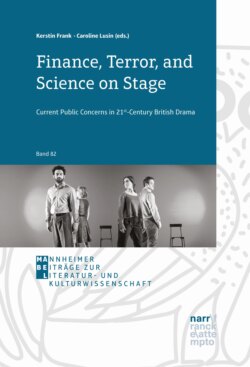Читать книгу Finance, Terror, and Science on Stage - Группа авторов - Страница 18
На сайте Литреса книга снята с продажи.
2. Immigration on the British Stage
ОглавлениеIt is, perhaps, an admissible generalisation that drama is uniquely suited to the presentation of conflict. The clash of rival positions is most evident if those are literally embodied by protagonists and antagonists. Thus the criss-crossing frontlines of any complex political debate can be made tangible; playwrights throughout the history of theatre have shown the power of such incarnations. These range from the emblematic figures of late mediaeval morality plays to the sophisticated characters (‘sophisticated’ not in the sense of socially advanced, but of ‘multi-dimensional’) of Brecht’s great tragedies. Narrowed down to the history of British immigration plays, the character spectrum stretches from Shakespeare’s Othello to Peter Flannery’s Singer (1989), via the captive Frenchmen in late Restoration comedy, to the stage Irish of 19th-century London plays, and the American characters of the comedy of manners.
Yet all of these, even if they are stock figures with predictable ideas, actions and linguistic peculiarities, are individuals. They do not represent the ethnic group they belong to, they merely exhibit its alleged characteristics. This makes them recognisable and, in the case of comedy, instantly entertaining, but they are not there to make points about immigration. The same is even true for tragic characters: Othello may be used as a starting point for a critical investigation into the conditions of immigration in Elizabethan and Jacobean England, but the play itself does not address them. The Moor is stigmatised by his skin colour, but not seen as the representative of the wider problem Venice (or indeed London) had with Barbary mercenaries.
The closest English-language drama gets to the topic of mass human displacement before the 1980s is the Irish emigration play, starting with some of Dion Boucicault’s 19th-century melodramas and encompassing plays like John B. Keane’s Many Young Men of Twenty (1946) and Brian Friel’s Philadelphia, Here I Come! (1964). Immigration as a subject in its own right only became visible on British stages once the immigrants themselves began to write. The work of Tanika Gupta may serve as a point of reference here, although plays by Kwame Kwei-Armah or Winsome Pinnock, to name but two other important contemporary playwrights, could be adduced.1 The immigrants in Gupta’s plays cover many reasons for displacement, from second-generation Indians with no intention of ‘going back’, to refugees fleeing the wars of the world, in Sudan (White Boy, 2008), Afghanistan (Fragile Land, 2003) or Rwanda (Sanctuary, 2002). Gupta’s audiences are never supposed to forget that these people are not merely interesting characters whose tribulations, well-dramatised, may move, entertain and instruct, but that their fate is symptomatic of a global miscarriage of humanity (cf. Griffin).
